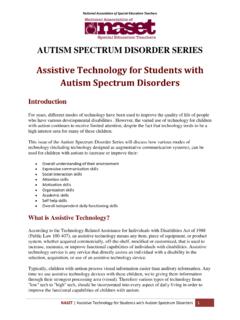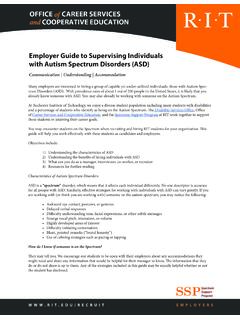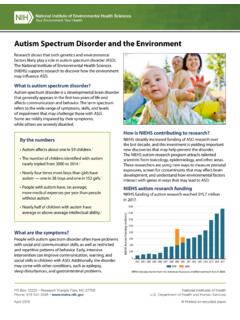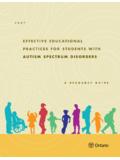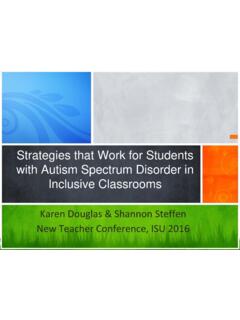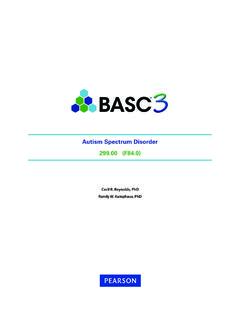Transcription of Effective Behavioral Intervention for Adults on the Autism ...
1 The Behavior Analyst Today Volume 11, Number 136 Effective Behavioral Intervention for Adults on the Autism spectrum : Best Practices in Functional Assessment and Treatment DevelopmentChristopher , James , Robert H. LaRue , Lara Delmolino & Donna SloanAbstractAs individuals with Autism age out of the educational system, families and practitioners are faced with a number of challenges, including placement concerns and limited Behavioral support. Among the most significant concerns is the assessment and treatment of challenging behavior in this population. While assessment and treatment strategies have been well described in the literature, practical solutions for Adults with Autism are needed. The current manuscript reviews some of the challenges to best practice with older learners andpotential risk factors associated with the absence of Effective Intervention .
2 Alternative assessment and treatment strategies , with implications for Adults on the Autism spectrum , are presented as part of the : Functional Behavioral assessment, function-based treatment, Adults , autism_____As individuals with Autism age out of the educational system, families and practitioners are faced with a number of challenges, including placement concerns and limited Behavioral support. This change in available resources often affects the quality of Behavioral Intervention available to Adults on the Autism spectrum . These concerns are highlighted when considering the prevalence of maladaptive behavior in adult populations. While estimates of the prevalence of problem behavior vary considerably, levels of maladaptive behavior tend to be higher for individuals with Autism relative to other disorders, and may include aggression,self-injurious behavior, property destruction, ritualistic behavior, disruption, inappropriate vocalization, and pica (among others).
3 It has been estimated that the prevalence of aggressive behavior ranges from to of cases, self-injuriousbehavior ranges from to of cases, and destructive behavior from to of cases (Holden & Gitlesen, 2004; Lowe, Allen, Jones, Brophy, Moore, & James, 2007).While procedures for assessment and treatment for these kinds of problem behavior are well-established in the Behavioral literature, the adult population presents unique challenges for families and care purpose of the current paper is to review the status of existing issues in functional assessment and treatment development in adult populations diagnosed with Autism . In addition, we will review some potential strategies for improving services to this underserved population.
4 Challenges to Functional Assessment and Treatment Development in AdultsWhile assessment and treatment procedures for problem behavior have been well established in the research literature, the representation of adult populations is generally lacking relative to younger populations (Hanley, Iwata & McCord, 2003). There are a number of factors which contribute to this relative dearth in the Perhaps the most salient reason for the lack of services (and subsequently, research) inadult populations is that the legislation mandating the use of functional Behavioral assessment and function-based Intervention procedures only extend to individuals to age 21. Upon reaching the age of 21, the adultpopulations are not provided with the same entitlements as their school-age counterparts with regard to functional Behavioral assessment and positive Behavioral supports.
5 Cost of Services. Providing services for Adults with Autism - spectrum disorders represents a substantial economic expense for families and government agencies (Cimera and Cohan, 2009; Ganz, 2006; J rbrink,McCrone, Fombonne, Zanden, & Knapp, 2007). Adults with Autism are among the most costly individuals with disabilities to serve, second only to those individuals with sensory impairments. It has been estimated The Behavior Analyst Today Volume 11, Number 137that it costs approximately $ million dollars to financially support an autistic person over their lifetime(Ganz, 2006). Considering that it is not uncommon for individuals with Autism to live into their sixties (Shavelle and Strauss, 1998), it is clear that care during adulthood represents a sizeable limited funds available , assessment and treatment practices are more likely to use less thorough models of assessment and treatment which require less time, money and other of Qualified Staff.
6 Another significant challenge to the use ofthe best available assessment and treatment practices with adult populations is a lack of qualified staff to conduct the assessments. It is often theresponsibility of direct care staff to implement comprehensive care plans even though many staffmembershave little training and/or direct care experience (Sigafoos, Roberts, Couzens, & Caycho, 1992; Wood, Luiselli, & Harchik, 2007). Challenges, such as lack of training/support and fear of injury, may deter otherwise qualified staff from working with this of Maladaptive Behavior. Other significant issues are more pragmatic in nature. Perhaps the most obvious difference between a child with Autism and an adult with Autism is the stature and physical strength of older learners.
7 Adults with Autism often engage in challenging behavior that is considerably more intense in comparison with the behavior of their younger counterparts. To this end, many people often avoid working with Adults with developmental disabilities who exhibit challenging behavior for fear of injury (Hastings and Brown, 2000). These characteristics deter many from working with this population of addition, these fears may alsounderstandably make staff less likely to use assessment procedures that would increase the likelihood of the challenging behavior ( , functional analysis), even though such environmental manipulations have the most empirical support for their of Challenging Behavior in Adults . Another issue that affects the use of functional assessment with Adults is the fact that intervening with challenging behavior tends to be more labor-intensiveand difficult with this population (Fox, Holtz, & Moist 2009).
8 Reasons for this may include a longer history of engaging in the behavior (Matson, 1988), multiple functions for the behavior (Rojahn & Schroeder, 1991), or multiple topographies of behavior (Borthwick-Duffy, 1994). The complexity of long standing and multiply controlled problem behavior can increase both thedifficultyand the duration ofthe assessment and for Untreated Problem Behavior in AdultsMore Intrusive Placements/Less Community Integration. Common goals for Adults with autisminclude independence in a variety of contexts and community integration through various supportedemployment opportunities andrecreational outings. Thepresence of persistent and/or ineffectively treatedmaladaptive behavior leads to more restrictive placements for older learners with Autism (Carr and Carlson 1993;Joyce, Ditchfield & Harris, 2001).
9 Theseplacements may include long term institutionalization or restrictive day treatment programs. Ultimately, problem behavior places Adults at risk for exclusion from community services, high levels of physical restraint, abuse from caregivers/day program staff, and self-inflicted injury (Allen, Lowe, Moore, & Brophy, 2007). Quality of Day Treatment Services. The quality of adult services provided in day treatment settings varies considerably. Reid, Parsons & Green (2001) recentlyevaluated 100 day program settings and found that approximately half of the adult clients were not engaged with any functional activity and were generally emitting high levels of off-task, stereotypical or self-stimulatory behavior, even when leisure materials were provided.
10 A similar study indicated that disabled Adults may not befunctionally engaged for up to 70% of the day (Parsons, Rollyson, & Reid, 2004). The possible relationship of this lack of engagement to challengingbehavior is two-fold. One, it is possible that the lack of functionalengagement seen in many of these settings is a result of untreated behavior problems. Clients with ASD may react negatively to the presentation of tasksor demands relatedto vocationa l or structured activities. Settings without proper supports (supports required The Behavior Analyst Today Volume 11, Number 138to create opportunities tailored for individual clients skills and preferences) may result in little or noexpectation to work in an attempt to avoid or end behavior problems.










